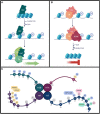Impaired Regulation of Histone Methylation and Acetylation Underlies Specific Neurodevelopmental Disorders
- PMID: 33488679
- PMCID: PMC7820808
- DOI: 10.3389/fgene.2020.613098
Impaired Regulation of Histone Methylation and Acetylation Underlies Specific Neurodevelopmental Disorders
Abstract
Epigenetic processes are critical for governing the complex spatiotemporal patterns of gene expression in neurodevelopment. One such mechanism is the dynamic network of post-translational histone modifications that facilitate recruitment of transcription factors or even directly alter chromatin structure to modulate gene expression. This is a tightly regulated system, and mutations affecting the function of a single histone-modifying enzyme can shift the normal epigenetic balance and cause detrimental developmental consequences. In this review, we will examine select neurodevelopmental conditions that arise from mutations in genes encoding enzymes that regulate histone methylation and acetylation. The methylation-related conditions discussed include Wiedemann-Steiner, Kabuki, and Sotos syndromes, and the acetylation-related conditions include Rubinstein-Taybi, KAT6A, genitopatellar/Say-Barber-Biesecker-Young-Simpson, and brachydactyly mental retardation syndromes. In particular, we will discuss the clinical/phenotypic and genetic basis of these conditions and the model systems that have been developed to better elucidate cellular and systemic pathological mechanisms.
Keywords: acetylation; epigenetics; histone; methylation; neurodevelopment.
Copyright © 2021 Fallah, Szarics, Robson and Eubanks.
Conflict of interest statement
The authors declare that the research was conducted in the absence of any commercial or financial relationships that could be construed as a potential conflict of interest.
Figures



Similar articles
-
Epigenetic modifications in the nervous system and their impact upon cognitive impairments.Neuropharmacology. 2014 May;80:70-82. doi: 10.1016/j.neuropharm.2014.01.043. Epub 2014 Feb 1. Neuropharmacology. 2014. PMID: 24495398 Review.
-
Epigenetic regulation in chondrogenesis.Acta Med Okayama. 2010 Jun;64(3):155-61. doi: 10.18926/AMO/40007. Acta Med Okayama. 2010. PMID: 20596126 Review.
-
Role of nucleosome remodeling in neurodevelopmental and intellectual disability disorders.Front Behav Neurosci. 2015 Apr 23;9:100. doi: 10.3389/fnbeh.2015.00100. eCollection 2015. Front Behav Neurosci. 2015. PMID: 25954173 Free PMC article. Review.
-
Chromatin modifications remodel cardiac gene expression.Cardiovasc Res. 2014 Jul 1;103(1):7-16. doi: 10.1093/cvr/cvu122. Epub 2014 May 8. Cardiovasc Res. 2014. PMID: 24812277 Review.
-
Epigenetic factors in intellectual disability: the Rubinstein-Taybi syndrome as a paradigm of neurodevelopmental disorder with epigenetic origin.Prog Mol Biol Transl Sci. 2014;128:139-76. doi: 10.1016/B978-0-12-800977-2.00006-1. Prog Mol Biol Transl Sci. 2014. PMID: 25410544 Review.
Cited by
-
Genotype-Phenotype Correlations in 2q37-Deletion Syndrome: An Update of the Clinical Spectrum and Literature Review.Genes (Basel). 2023 Feb 11;14(2):465. doi: 10.3390/genes14020465. Genes (Basel). 2023. PMID: 36833393 Free PMC article. Review.
-
Hearing loss and brain disorders: A review of multiple pathologies.Open Med (Wars). 2021 Dec 15;17(1):61-69. doi: 10.1515/med-2021-0402. eCollection 2022. Open Med (Wars). 2021. PMID: 34993346 Free PMC article. Review.
-
Antineoplastic activity of plant-derived compounds mediated through inhibition of histone deacetylase: a review.Amino Acids. 2023 Dec;55(12):1803-1817. doi: 10.1007/s00726-023-03298-x. Epub 2023 Jun 30. Amino Acids. 2023. PMID: 37389730 Review.
-
Harnessing the Power of Stem Cell Models to Study Shared Genetic Variants in Congenital Heart Diseases and Neurodevelopmental Disorders.Cells. 2022 Jan 28;11(3):460. doi: 10.3390/cells11030460. Cells. 2022. PMID: 35159270 Free PMC article. Review.
-
Lysine crotonylation in disease: mechanisms, biological functions and therapeutic targets.Epigenetics Chromatin. 2025 Mar 22;18(1):13. doi: 10.1186/s13072-025-00577-7. Epigenetics Chromatin. 2025. PMID: 40119392 Free PMC article. Review.
References
-
- Alarcón J. M., Malleret G., Touzani K., Vronskaya S., Ishii S., Kandel E. R., et al. . (2004). Chromatin acetylation, memory, and LTP are impaired in CBP+/– mice: a model for the cognitive deficit in rubinstein-taybi syndrome and its amelioration. Neuron 42, 947–959. 10.1016/j.neuron.2004.05.021 - DOI - PubMed
-
- Arboleda V. A., Lee H., Dorrani N., Zadeh N., Willis M., Macmurdo C. F., et al. . (2015). De novo nonsense mutations in KAT6A, a lysine acetyl-transferase gene, cause a syndrome including microcephaly and global developmental delay. Am. J. Hum. Genet. 96, 498–506. 10.1016/j.ajhg.2015.01.017 - DOI - PMC - PubMed
Publication types
LinkOut - more resources
Full Text Sources
Other Literature Sources

